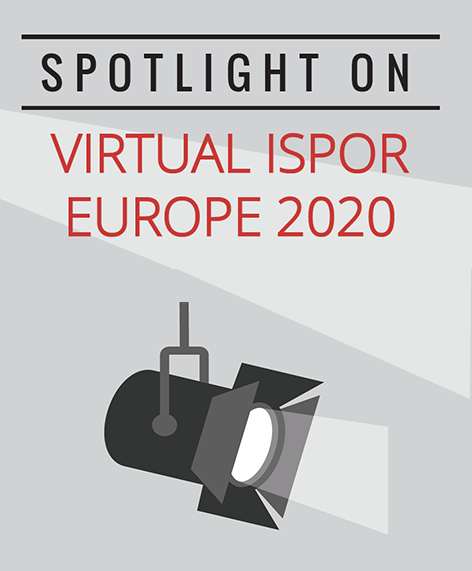The Use of Surrogate Endpoints in Regulatory and HTA Submissions
Felix Wolfrum, MSc, Department of Applied Natural Sciences, TH Köln - University of Applied Sciences, Cologne, NRW, Germany; and Vasco Pontinha, MPharm, MA, Department of Pharmacotherapy and Health Outcomes, Virginia Commonwealth University School of Pharmacy, Richmond, VA, USA
Sylwia Bujkiewicz, PhD, Msc, Biostatistics Research Group, Department of Health Sciences, University of Leicester, United Kingdom kicked off this workshop explaining how the development of new therapies with alternative modern studies bring several challenges to the regulatory agencies and the wider HTA sector.
“Uncertainty is key. The strength of the surrogate relationship will be reflected in the level of uncertainty around the predicted treatment effect on the final outcome.” —Sylwia Bujkiewicz
Surrogates: A Brief Overview
Targeted therapies are often utilized by a smaller population with reduced number of deaths, and result in longer follow-up periods for overall survival. Therefore, estimates of the treatment effects can lead to uncertainty in an early follow-up. To address this limitation, surrogate endpoints—like biomarkers—are used to predict the clinical outcome (Figure 1). Cost efficiency, reduced invasiveness, and shorter follow up periods to achieve usable results are often listed as advantages of using surrogate endpoints. However, the evidence of effectiveness on the target outcome is limited. To address this problem, it is necessary to validate surrogate endpoints. Bujkiewicz discussed the process of validation of those endpoints following a 3-step framework. The result is an evidence-based proof of the correlation of effects on surrogate parameters and final clinical outcome based on multiple randomized controlled trials. In conclusion, the evaluation and consideration of uncertainty is key to the implementation of the HTA framework.
Figure 1. Surrogate Endpoint Linkage
Strength of Association
Huseyin Naci, PhD, Department of Health Policy, London School of Economics and Political Science, London, United Kingdom expanded on this topic by explaining how surrogate endpoints have been used in recent years for regulatory approval of treatment for diseases such as cancer, cardiometabolic diseases. In cancer, the use of these endpoints for regulatory approval is not only common, but the approval is even considered for expedited pathways. However, Naci questioned whether regulatory authorities are even concerned with the validity of these endpoints. She argued, showing data from a recent study [Prasad et al, JAMA Intern Med. 2015;175(8):1389–1398], how surrogate endpoints for cancer demonstrated low to medium association with overall survival. Thus, it is possible that the treatment effects are potentially exaggerated compared to data generated post-approval.
“Surrogate endpoints should be adequately validated: the surrogate-final endpoint relationship must have been demonstrated based on biological plausibility and empirical evidence.” —Oriana Ciani, PhD
The HTA Perspective
A study conducted by Oriana Ciani, PhD, Centre for Research on Health and Social Care Management (CERGAS), SDA Bocconi School of Management, Milan, Italy showed how 29 HTA agencies published specific guidance for using surrogate endpoints. The consensus was adequate validation by surrogate and final endpoint relationships based on biological plausibility and empirical evidence is needed. Nevertheless, surrogates were used in 40% of the cases, with only 22% of cases reporting a strong association with the final endpoint. Ciani suggests that the use of surrogates should be seen in the context of the treatment, despite the different approaches between NICE and IQWiG/G-BA. She concluded that surrogates can be used as prognostic markers or predictors of utility, but it is necessary to demonstrate and implement robust validation methods in the HTA reports.
A NICE Update
Why include surrogates in the methods? Dalia Dawoud, PhD, Science Policy and Research Programme, National Institute for Health and Care Excellence (NICE), London, United Kingdom approached this question in light of the forthcoming changes by NICE. Considering the continued shift towards generating early evidence, as well as increased use of surrogates in regulatory approval, Dawoud argued that currently there is limited evidence around the validity of the relationship between surrogate and outcomes. This relationship is the cornerstone for a compelling assessment. A systematic literature review found that it is necessary to validate this relationship in order to address uncertainties and subgroup effects. Consequently, Dawoud recommended the validation of a surrogate endpoint using, for example, meta-analyses. However, she warned, these validations are likely specific to each technology and population and any subsequent extrapolation needs to be thoroughly justified.
In a lively Q&A session, a fundamental question was addressed by the panelists (Figure 2) what happens when two products show comparable overall survival but one exhibits better progression-free survival? Should a surrogate endpoint predict or, at least, be correlated to a better clinical outcome for validation purposes?
Figure 2. Workshop Panelists.

Ciani argued that the validity of the surrogate is linked to its ability to reliably predict the effect (or lack thereof) on the clinical endpoint of interest. In the example provided, there seems to be no uncertainty on the final outcome (overall survival), but higher progression-free survival may be preferred and considered as related to better quality of life or lower direct medical costs.


